Newsletters
- Home
- Publications
- Newsletter Archive
- Newsletter
March/April 2018
Inside This Issue:
- Lingering Effects of the Great Recession
- Public Hearing on Broadband Set for April 5
- Chairman's Message
- Rural Snapshot: Devices and Internet Connectivity
- Fast Fact: Location of Approved Medical Marijuana Practitioners (as of February 2018)
- Did You Know. . . Female Elected Municipal Officials in 2018
- Just the Facts: Big Families
Pennsylvania's Rural Economy
Lingering Effects of the Great Recession
It’s been more than nine years since the Great Recession hit U.S. households, businesses, and the overall economy. This 19-month downturn, which started in December 2007 and ended in June 2009, caused unemployment rates to escalate, home foreclosures to spike, household incomes to drop, and businesses to close their doors. Almost a decade later, the nation and Pennsylvania have seen signs of recovery, but some effects of the recession still seem to linger.
To better understand how rural and urban Pennsylvania have fared since the end of Great Recession, the Center for Rural Pennsylvania examined data from the U.S. Bureau of Labor Statistics, and the U.S. Census Bureau to analyze a range of economic indicators, including employment, unemployment, wages, and housing.
Overall, the analysis found that employment, the number of businesses, and the number of housing starts in rural Pennsylvania have not returned to pre-recession levels.
For example, from 2007 to 2017, rural Pennsylvania lost 96,100 jobs. During the same period, urban Pennsylvania gained 145,200 jobs. Among Pennsylvania’s 48 rural counties, 17 had job losses of 10 percent or greater.
Regarding unemployment, both rural and urban Pennsylvania saw it peak in 2010, a year after the recession ended. Since then, both rural and urban Pennsylvania have seen a gradual decline in the unemployment rate. However, neither rural nor urban unemployment rates have fallen below their pre-recession levels.
One bright spot in the recovery is that average weekly wages for rural workers have increased slightly from 2007 to 2017, from $744 to $806. Also, the wage gap between rural and urban workers has narrowed somewhat. However, urban workers still earn 28 percent more per week, on average, than rural workers.
The number of new housing starts has not yet returned to pre-2008 levels in both rural and urban Pennsylvania and there was also a decline in housing values. From 2009 to 2016, Census data show that rural home prices, on average, declined 2 percent, from $162,500 in 2009 to $159,400 in 2016. In urban areas, housing prices had an even a steeper decline, 8 percent on average, from $247,600 in 2009 to $228,700 in 2016.
The analysis also revealed that rural Pennsylvania is not alone in its post-recession economic languor, as rural America also continues to experience a slow economic recovery. Similarly, the economic gap between rural and urban America has increased, making future growth for rural areas more challenging.
The fact sheet, Nine Years and Counting: Rural Pennsylvania’s Economy After the Great Recession, is available here.
Number of Rural and Urban Pennsylvania Employees, 2007 to 2017*
Note: Graph not to scale.
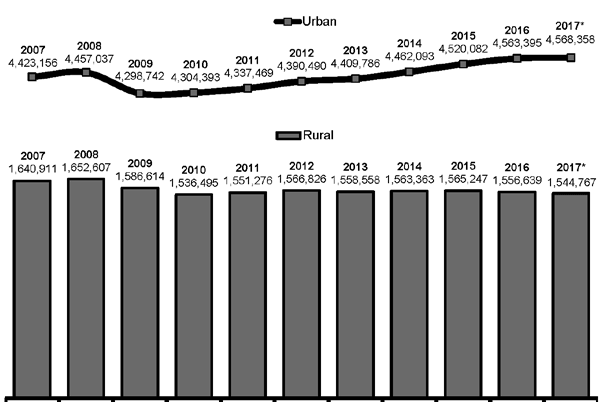
*2017 represents a 12-month average (January to December) of non-seasonally adjusted employment. Data are benchmarked to 2017. Data source: Local Area Unemployment Statistics, U.S. Bureau of Labor Statistics.
Rural and Urban Pennsylvania Unemployment Rates, 2007 to 2017*
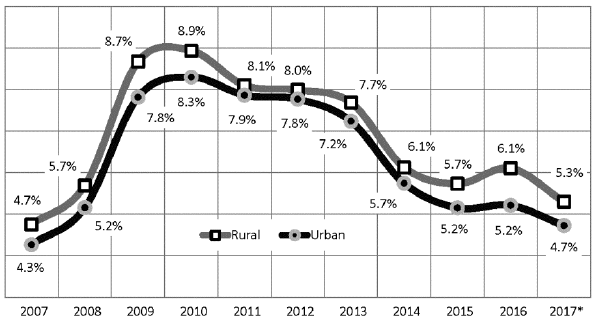
*2017 represents a 12-month average (January to December) of non-seasonally adjusted employment. Data are benchmarked to 2017. Data source: Local Area Unemployment Statistics, U.S. Bureau of Labor Statistics.
Rural and Urban Pennsylvania Average Weekly Wages, Second Quarters, 2006 to 2017
(Adjusted for Inflation)
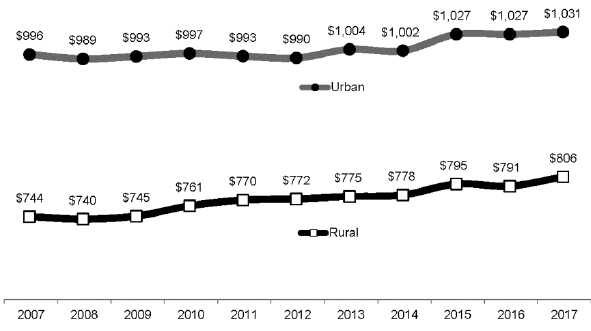
Data adjusted for inflation using the CPI-U with 2017=100. Analysis only included data assigned to a specific county. Data source: Quarterly Census of Employment and Wages, U.S. Bureau of Labor Statistics.
Public Hearing on Broadband Set for April 5
On April 5, the Center for Rural Pennsylvania’s Board of Directors will host a public hearing on broadband access and availability in rural Pennsylvania. The public hearing will be held at the Penn Wells Hotel in Wellsboro, Pa., beginning at 9 a.m.
“Broadband access means so much more than interactive gaming or connecting with your family and friends,” said Center Board Chairman Sen. Gene Yaw. “Broadband access also means having access to your healthcare provider, completing a classroom assignment, and maintaining and expanding your business. The Center’s board will receive testimony on the challenges and opportunities regarding rural broadband deployment because it impacts a large part of our everyday lives.”
More information about the hearing is available here.
Chairman's Message
In January, the Center announced its 2018 research grant awards, one of which is a year-long project to analyze broadband access across Pennsylvania.
Dr. Sascha D. Meinrath of Pennsylvania State University, and a team of researchers, will provide a comprehensive look at the current availability of high-speed, fixed broadband services in rural Pennsylvania. Dr. Meinrath is using the Federal Communications Commission’s current definition of broadband, which is defined as a connection with 25 megabits per second as the minimum download speed and 3 megabits per second as the minimum upload speed.
The Center’s Board of Directors was eager to move forward with this research since broadband access is so important to the economic vitality and overall welfare of our rural communities.
We have heard, firsthand, from people and businesses in our communities about the challenges in having quality broadband access at home and at work. While many of us access the internet with the touch of a finger on a cell phone or a computer at home, in a coffee shop or even in our car, think about the high school student whose only reliable access is at her school and she is working on a research project as a graduation requirement. Or what about the small business that wants to expand operations by marketing its goods and services on the internet and the only access is over a landline? What about the rural campground owner whose customers want high-speed internet access? And how can home health aides transmit data back to a clinic or hospital if there is no high-speed connection in the communities they serve? In today’s global society, the availability, accessibility and affordability of industry-standard, broadband access remain a challenge for rural areas of Pennsylvania.
As part of the Center’s commitment to this issue, the board will also be hosting a public hearing on April 5 as noted on Page 1. We want to hear from providers and consumers about the issues, challenges and opportunities of delivering broadband services in rural Pennsylvania. It is recognized that the geography of rural Pennsylvania and the lack of population are issues that affect availability, access and cost. Yet, we also have seen that rural Pennsylvania can serve as a testbed for innovation and unique ways of dealing with the challenges of geography and isolation.
From the research currently underway and the public hearing, the Center will gather and share the findings and information with the General Assembly and others. We hope to help identify options and viable solutions on how to expand and deploy broadband throughout rural Pennsylvania.
Senator Gene Yaw
Rural Snapshot: Devices and Internet Connectivity
This Rural Snapshot looks at the devices Pennsylvanians use and the type of internet connection that is available and accessible to them. The data source for the graphics is the Federal Communications Commission, unless otherwise noted.
Types of Devices in Rural and Urban PA Households, 2016
Data source: 2016 American Community Survey, Public Use Microdata Sample, U.S. Census Bureau.
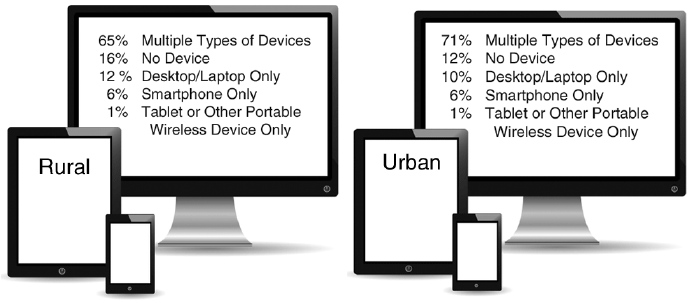
Residential Internet Availability by Rural and Urban PA Population (Census Blocks), 2016
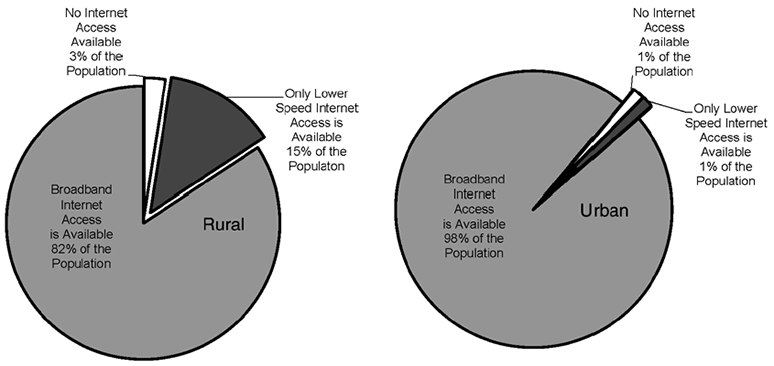
Note: If one internet provider in a Census Block reported residential broadband access is available, then the entire Block is defined as having broadband access. Broadband is defined as 25 Mbps download and 3 Mbps or higher upload. Low speed is defined as less than 25/3 Mbps. Excluded are wireless and satellite internet providers. Rural/urban status is based on county. Population data are from the 2010 Census, U.S. Census Bureau.
Internet Connectivity Among Rural and Urban PA Households, 2016
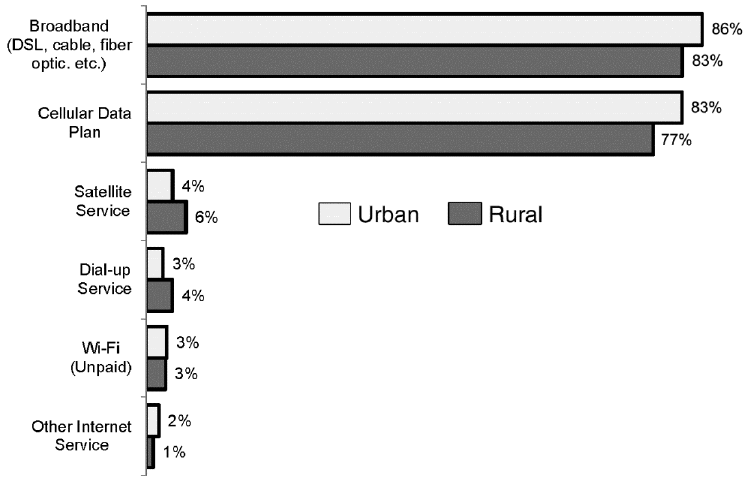
Note: Total will not add up to 100 percent due to households having multiple methods of accessing the internet. ACS-PUMS does not provide a definition of speed for broadband connectivity. Data only include households with internet access. Data source: 2016 American Community Survey, Public Use Microdata Sample, U.S. Census Bureau.
Number of Broadband Internet Service Providers, 2016
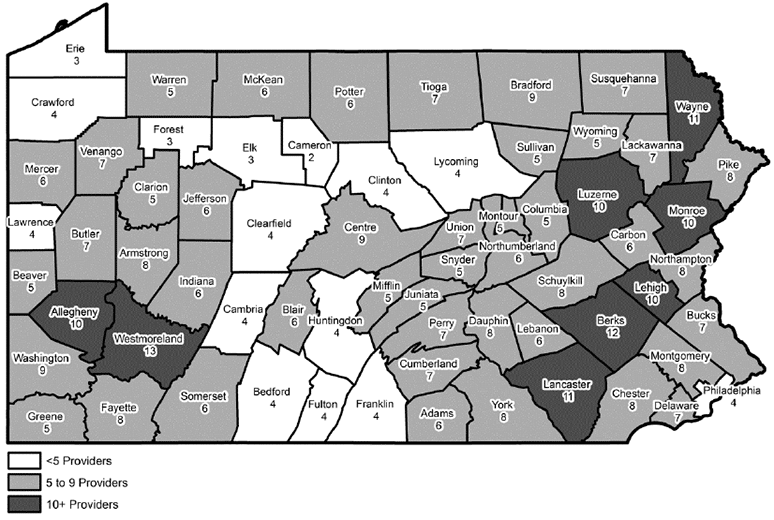
This map shows the number of unique residential broadband internet service providers that reported providing service in one or more Census Blocks in each county. Broadband is defined as 25 Mbps download and 3 Mbps or higher upload. Excluded are wireless and satellite internet providers.
Rural PA Households Without Internet Access
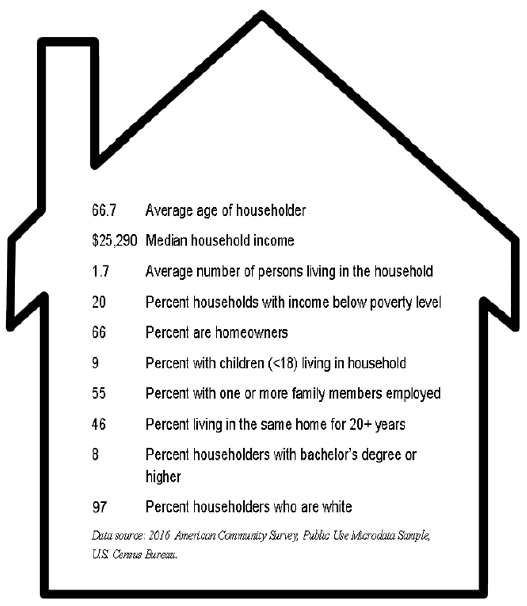
Census Blocks with Residential Broadband Access, 2016
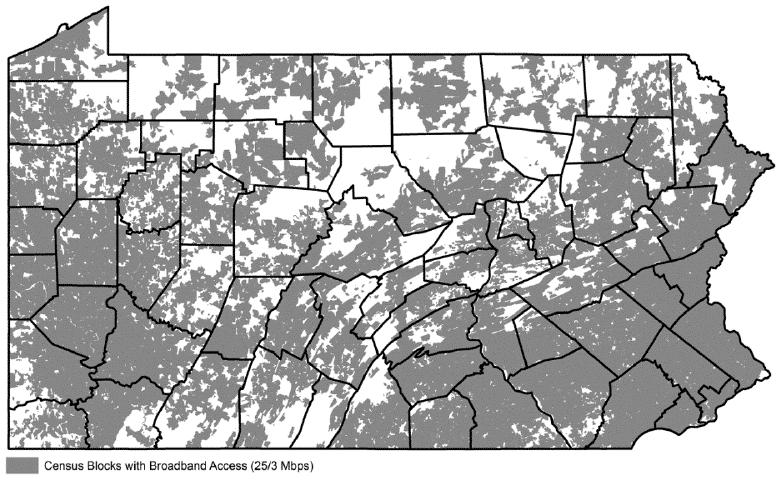
Note: If one internet provider in a Census Block reported residential broadband access is available, then the entire Block is defined as having broadband access. Broadband is defined as 25 Mbps download and 3 Mbps or higher upload. Low speed is defined as less than 25/3 Mbps. Excluded are wireless and satellite internet providers. Rural/urban status is based on county. Population data are from the 2010 Census, U.S. Census Bureau.
Fast Fact: Location of Approved Medical Marijuana Practitioners (as of February 2018)
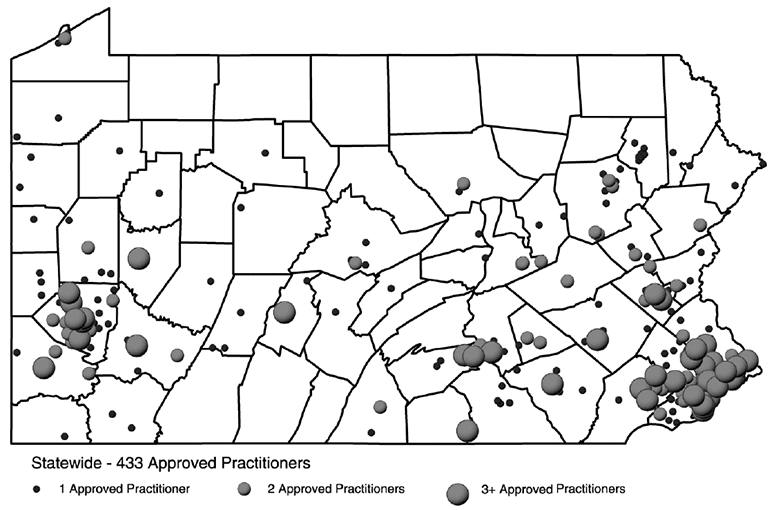
Note: Location according to Zip Code. Data source: Pennsylvania Department of Health.
ïµ The state's Medical Marijuana Program was signed into law on April 17, 2016 ïµ The Pennsylvania Department of Health is charged with implementing the program ïµ According to the Pennsylvania Department of Health, the program will provide access to medical marijuana for patients with a serious medical condition ïµ More information about the program is available at www.pa.gov/guides/pennsylvania-medical-marijuana-program/.
Did You Know. . . Female Elected Municipal Officials in 2018
963 Number of female elected municipal officials (township supervisor, borough council member, etc.) in rural Pennsylvania. They make up 15 percent of the total 6,533 rural elected municipal officials.
1,497 Number of female elected municipal officials in urban Pennsylvania. They make up 24 percent of the 6,248 urban elected municipal officials.
3 Percent increase in the number of rural female elected municipal officials from 2011 to 2018. Among urban female elected municipal officials there was a 15 percent increase.
45 Percent of rural female elected municipal officials who are Republican; 31 percent are Democrat, 4 percent are independent or other party, and 20 percent did not report their political affiliation.
35 Percent of urban female elected municipal officials who are Republican; 54 percent are Democrat, 2 percent are independent or other party, and 9 percent did not report their political affiliation.
35 Percent of the 1,576 rural municipalities that have one or more female elected municipal official (where the gender of elected officials was reported). 65 percent have no female elected municipal official.
74 Percent of the 964 urban municipalities that have one or more female elected municipal official (where the gender of elected officials was reported). 26 percent have no female elected municipal official.
Data source: Governor's Center for Local Government Services, Pennsylvania Department of Community and Economic Development.
Just the Facts: Big Families
It’s no surprise that family sizes have been shrinking over the past few decades. In 1970, rural families had 3.5 people, on average, according to U.S. Census Bureau data. By 2016, the average dropped to 3.0. The Census defines a family as a group of two or more people related by birth, marriage, or adoption, and residing together.
Despite this downward trend in family size, big families still exist. To learn more about big families, which are defined as families with six or more members, the Center for Rural Pennsylvania analyzed data from the U.S. Census Bureau’s 2016 American Community Survey, Public Use Microdata Sample (ACS-PUMS).
According to the data, in 2016, big families made up 3 percent of rural Pennsylvania’s 1.06 million families and 4 percent of urban Pennsylvania’s 2.10 million families. Nearly all rural and urban big families (96 percent) had children under 18 years old. On average, the rural big families included 3.6 children and the urban big families included 3.4 children.
Nearly one in three rural and urban big families (32 percent) was multigenerational; that is, there were three generations living together. Additionally, 85 percent of rural big families and 80 percent of urban big families were headed by a married couple.
Seventy-eight percent of rural and 74 percent of urban big families lived in their own home. These homes had four bedrooms, on average. The median value of the rural big family home was $170,000, and the urban median was $235,000.
The median income of rural big families was $74,562, and $82,824 for urban big families. Eighteen percent of both rural and urban big families were in poverty, and 26 percent of rural and 36 percent of urban big families received SNAP benefits. Sixty-seven percent of rural big families and 72 percent of urban big families had two or more family members who were employed.
In 2016, 79 percent of rural and 82 percent of urban big families received no income from agricultural sales.
Among all rural big families, 45 percent had three or more vehicles, 42 percent had one to two vehicles, and 12 percent had no vehicle. Among urban big families, 42 percent had three or more vehicles, 46 percent had one to two vehicles, and 11 percent had none.
Across the U.S., there were nearly 3.89 million big families, or 5 percent of all families. The states with the largest percentages of big families were Utah, Hawaii, Alaska, California, and Idaho. In each, big families made up more than 6 percent of all families. The states with the lowest percentages of big families were Rhode Island, Maine, New Hampshire, and Vermont. In each of these states, big families made up less than 3 percent of all families. Among all 50 states, Pennsylvania had the 32nd highest percentage of big families, with 4 percent.
